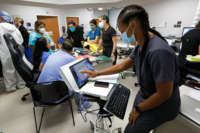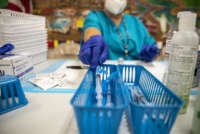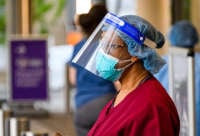Residency training often claims to focus on training effective physicians. In reality, it’s an intricately designed conditioning process to train physicians to be tools for profit maximization. In order to be truly “effective” physicians, residents, in solidarity with other healthcare workers, must organize to challenge the systems that lead to suffering and illness both in health care and around the globe.

The end of medical school is a moment that, for many medical school graduates, is several years — sometimes several generations — in the making. After four grueling years the graduate is ready to officially get that “MD” behind their name. But what else has the four years of medical school done for the soon-to-be physician? As previously discussed, medical school is not an apolitical environment in which “medical knowledge” is simply passed on to each student. Mechanisms are put in place to condition students to be less likely to question systems of power. Overall, the medical school structure serves as an indoctrination system. By the time they graduate, medical students are forced to take on massive amounts of student loans — the average medical school graduate has around $250,000 in student loan debt — which serves as a form of economic control and coercion. By conditioning thought and using economic coercion, the medical education system helps make the physician more likely to participate in and help maintain a capitalist healthcare system whose focus is extracting monetary value from people’s bodies damaged by capitalism and colonialism.
This indoctrination starts even before medical school as the educational system filters for a medical school candidate from a particular class and racial background. Folks from working-class backgrounds are systematically excluded from medical school education — from premedical courses designed to “weed out” students, few opportunities for mentorship, and unsupportive career counselors to hard-to-meet shadowing or extracurricular requirements to the highly prohibitive costs of standardized testing, applications, and interviews. To be clear, these dynamics are nothing new. In his book Rockefeller Medicine Men: Medicine and Capitalism in America, E. Richard Brown cites concerns raised by education leaders as far back as 1908, when the Association of American Medical Colleges (AAMC) was criticized for changing attendance requirements for medical school. As Brown states, the proposed requirement for a college education before attending medical school would “exclude poorer classes from their [medical school] ranks.”
This trend continues today. According to an analysis from the AAMC, the median family income of matriculating medical students has only increased over the years, and it will likely further systemically skew upward in the coming years. These filtering mechanisms also serve to limit the political perspectives of incoming medical students, making it even easier to structure the collective thought of students once they are in medical school.
After all this, what comes next for the new doctor? Medical residency. Medical residency lasts anywhere from three to seven years depending on the medical specialty. It is considered the place where physicians learn to “practice” the “art of medicine.” But what actually happens in residency? Residents work long hours for large corporations while being told that their work conditions are beneficial to their “learning.” In reality, though, residents work as cheap labor for the medical industrial complex. During residency, trainees learn to respect the corporate hierarchy, keep their heads down, be subservient to authority, and, most importantly for the capitalist medical system, how to more efficiently funnel patients through medical factories for profit.
A Brief History of Modern Medical Education
To discuss medical residency, we must understand how residency serves as a training program to produce physicians who function within and perpetuate the capitalist medical system. The field of medicine supporting the foundational structures of capitalism in a settler-colonial society is nothing new. For example, as E. Richard Brown cites, in Walter Fisher’s study of medicine’s role in the antebellum South, Fisher concluded that enslaved people were given medical care mainly because of “the tremendous economic investment they represented to slave owners.” Additionally, medicine was weaponized to justify the racial hierarchy that serves capitalism. As medicine became more modernized and education more formalized, it was important to ensure physicians were trained to practice medicine in a particular way. A document crucial in setting this path for modern American medical education was the Flexner Report.
As educators of the Health Justice Commons (HJC) discuss, the Flexner Report, a landmark document written by Abraham Flexner and commissioned by the Carnegie Foundation, helped set the standards for modern medical education. The report was critical in helping shift modern American medical education to a strictly biomedical focus. As the HJC discusses, the report alienated traditional healers, criminalized alternative forms of care, and deemed women and people of color unfit to participate in medical education. In Rockefeller Medicine Men, Brown cites Flexner’s views that the practice of Black doctors be “limited to his own race.” Flexner perpetuated racist views about disease transmission by advocating for “improved training for Black physicians” largely because whites lived near Black people. These prejudices translated to medical school reforms and closures. Post-report, Black medical schools were disproportionately affected by closure, with 71 percent of Black medical schools closing compared to 55 percent of white institutions. Of the seven Black medical schools in existence at the time, only Meharry and Howard survived.
The report also helped solidify a medical education system that systematically excludes applicants of working-class backgrounds, arguably institutionalizing the elitism of the medical education system. Flexner believed the previous requirement of just four years of high school before medical school attracted “a mass of unprepared youth drawn out of industrial occupations into the study of medicine.” As Brown notes, “Neither the ‘crude boy’ nor ‘the jaded clerk’ were suitable material for a career in medicine.” Flexner’s prescription was to require college before medical school. Brown emphasizes that this occurred at a time when “only 15 percent of the high school age population was enrolled in high school and only 5 percent of the college age population was enrolled in a college or university.”
In the early 20th century large monopoly families were constantly exploring how to increase their wealth and power by controlling societal institutions. The Rockefellers, for example — a family headed by J.D. Rockefeller, an American capitalist and oil baron who profited off the Holocaust — founded the Rockefeller Institute for Medical Research in 1901 to privately fund medical research. Families such as the Morgans (of JP Morgan) were also active in the research-focused Carnegie Foundation, which they used to exert greater control over legislative and governmental bodies.
The Rockefeller Foundation was headed by Dr. Simon Flexner and notably did not support research investigating the connection between social factors, health, and disease. The ruling elites had no interest in changing society for the general health and well-being of the populace as an end in itself. Instead, research was explored in order to make the public healthy enough to labor, to be further exploited by capitalists. These ruling-class families also hoped to integrate these changes in medical education with contemporary reforms in education more generally to further expand their influence.
In 1907, in the context of these larger reforms, the head of the newly reformatted American Medical Association (AMA), surgeon and professor at Rush Medical College, Arthur Dean Bevan, invited the head of the Carnegie Foundation for the Advancement of Teaching, Henry Pritchett, to discuss the possibility of a Carnegie-sponsored study on medical education. Eventually Simon Flexner’s brother, Abraham Flexner, was appointed director of this study, even though he had no experience in medicine. And thus, Abraham Flexner’s “Flexner Report” was born.
While there can be arguments made around potential benefits of “standardizing” quality in medical education, as HJC notes, medical education’s shift to pure biomedicine has created captive markets of communities seen as disease vectors to be controlled through “healthcare.” In doing so, these reforms helped create vertical, high-profit industries in which patients become dependent consumers. The focus on biomedicine also served the financial interest of the medical industrial complex by not treating the root causes of illness, for self-preservation of the medical industrial complex itself. Additionally, it absolves the other interconnected industrial complexes (military, pharmaceutical, fossil fuel, manufacturing, farming) and allows their catastrophic effects on the well-being of the environment and communities to continue. As Brown notes, “The Flexner report united the interests of the elite practitioners, scientific medical faculty, and the wealthy capitalist class.”
Medical Residency as a Tool for Indoctrination and Labor Extraction
In their book Social Medicine and the Coming Transformation, physicians and activists Howard Waitzkin, Alina Pérez, and Matthew Anderson discuss how the training and education of healthcare workers can serve the interests of the capitalist system. They cite the work of Vincent Navarro, Spanish physician, sociologist, and political scientist who maintained there is a minimum level of health for the working class if it is to work. As a result an alliance must arise between the capitalist class and medical profession, as healthcare workers are needed to perpetuate the belief that the main causes of ill health are personal and biogenetic rather than social and commonly caused by the very occupations in which people work. Changes made to medical education as a result of the Flexner report, which continue to this day, helped to bolster this alliance. It is the job of healthcare workers who want to destabilize these oppressive systems to grapple with and struggle against this system of education. Today an elaborate array of conditioning mechanisms and structures are now in place to uphold these dynamics. Let’s discuss how some of these mechanisms function.
Throughout medical school and residency training, students and trainees are subject to a series of licensing and board certification examinations. Studies have demonstrated that there is little to no correlation between United States Medical Licensing Exam (USMLE) scores and clinical performance in residency. Instead of ensuring the production of competent, compassionate physicians prepared to address the structural factors that cause illness and suffering, these examinations function to promote conformity and the status quo. Studying for these examinations can be all consuming, thereby diverting time from questioning and challenging harmful systems to test preparation.
Additionally, these tests ensure a constant source of revenue for test preparation companies, testing companies, and organizations, such as the Federation of State Medical Boards (FSMB) and the National Board of Medical Examiners (NBME), the licensing and testing bodies, respectively. In fiscal year 2019, the NBME reported a revenue of $180 million, with $177 million operating costs and a profit of $3 million. The FSMB reported a profit of $4.7 million in 2019, and in 2020, their CEO was compensated $726,518. This tax data, available on ProPublica’s Nonprofit Explorer, is an example of how nonprofit organizations function like corporations within the nonprofit industrial complex. Test preparation for USMLE licensing exams and specialty boards is also highly profitable, forming part of the billion-dollar test prep industry. Preparation courses and practice-question banks all come at a cost, which can be prohibitive to first-generation or low-income students and trainees, which serves to further exclude people of color and working-class people from becoming physicians. In summary, standardized testing with an emphasis on physician competence disguises the real goal of producing physicians for the extraction of profit from bodies damaged by capitalism and is also profitable in and of itself.
Medical residency is also profitable to hospital systems. Let’s look at the data on Medicare Graduate Medical Education (GME) payments, which has been compiled here. Payments consist of direct and indirect costs of resident education, that is, the salary and benefits of residents and their attending preceptors and program operating costs, respectively. The Per Resident Amount (PRA) paid for each resident significantly exceeds the resident salary. For example, in 2018, Howard University Hospital was paid a PRA of $169,206 for primary care specialties, while the salary for a first-year resident was $50,628.36. The 2017 paper “Eliminating Residents Increases the Cost of Care” calculated the cost of replacing residents. Residents are paid less and work more than their replacements (they are not to work more than 80 hours weekly averaged across four weeks, as established by the Accreditation Council for Graduate Medical Education or ACGME, a body further discussed below). By the author’s calculations, the cost of replacing 1.0 Full Time Equivalent (FTE) internal medicine resident with 1.8 FTE Nurse Practitioner would be $168,104. The cost of replacing 1.0 FTE anesthesiology resident with 1.5 FTE Certified Registered Nurse Anesthetist would be $218,111. They conclude that “GME programs are a positive factor in hospital finances and should not be considered a financial risk.” Though hospital leadership pretends they are doing a service by “training the next generation of doctors,” the financial incentive is clear. Hospital CEOs do not care about training competent physicians; they care about improving their bottom line with cheap, overworked resident physicians.
In addition to being inherently profitable, medical residency serves as an indoctrination process for the production of physicians who will be complicit with the medical industrial complex. The Accreditation Council for Graduate Medical Education (ACGME) is the accrediting body for residency and fellowship programs, whose stated purpose is “improving the patient care delivered by resident and fellow physicians today, and in their future independent practice.” How does the ACGME determine when a resident physician has become “competent”? For one, through dictating the number of patients that should be seen during residency, with an emphasis on clinical efficiency during a 15–20 minute “patient encounter.” This number is 1,650 for family medicine residents, with the implication being that volume equals learning.
Does it? Do residents learn to be compassionate listeners? Do they understand their patient’s illness experience and the oppressive systems that cause suffering? Do they have time to fight these systems outside the hospital or examination room? Do they have time to adequately precept and learn from their attending physicians? Do they have the option to slow down to learn if they need more time or support without fear of being placed on academic observation or probation?
No, they learn to see human beings as a “single problem for today’s visit,” interrupt them midsentence, and further traumatize, police, and perpetuate harms of medical racism and the like. This practice is particularly damaging and exploitative given that residency programs commonly provide medical care in oppressed communities. Education about the systems that produce illness would cause the resident to conclude that the healthcare system, which commodifies illness and maximizes financial extraction from bodies damaged by capitalism and colonialism, must be dismantled entirely. Additionally, the ACGME says they value resident “well-being” and “patient safety,” which is why the 80-hour workweek was standardized. Eighty hours a week, however, is the equivalent of two full-time jobs, which leads to exhausted residents attempting to care for patients and increased risk of medical errors. Yet this comical “work limit” is maintained to give the perception of caring about well-being (of both resident and patient) while solidifying the place of the resident as a cog in the wheel of the medical industrial complex.
Residency programs themselves take a crucial role in conditioning physicians. One way programs do this is by co-opting “woke” terminology in discussing the training of physicians without implementing policies that would change the actions of physicians practicing. For example, take implicit bias training, lauded in “social justice”–oriented residencies around the country. A study published in the Journal of Personality and Social Psychology in 2019 titled “A Meta-analysis of Procedures to Change Implicit Measures” brought together 492 studies on procedures used to change the implicit biases that influence behavior. The study “found little evidence that changes in implicit measures translated into changes in explicit measures and behavior.” Yet despite data showing these trainings are ineffective, they continue because they allow residency programs to appear as if they are teaching physicians to address systemic problems.
This sets up a dynamic, which MD/PhD student Ariel Hart references in their piece on Medium titled “what i know to be true:” where “Talking about implicit bias, structural competency, health inequities and even anti-racism can take up a lot of time and energy and most of the times is a checkbox, to make people feel good about doing next to nothing to actually uproot structural violence in our society.” Programs use these checkboxes to pretend they are “doing the work,” but as Hart explains “we will not ‘implicit bias,’ ‘structural competence’ or ‘health inequity’ training ourselves out of this. We need to explicitly name and target colonialism, capitalism, racism, sexism, and other oppressions.”
In residency programs around the country there also is a focus on “wellness” to address higher rates of “depressive disorders, depressed mood, burnout, and suicidal ideation” among medical residents when compared to their nonmedical peers. Studies demonstrate that “male doctors have suicide rates as much as 40 percent higher than the general population, and female doctors up to 130 percent higher.” While the causes of depression and suicide are multifactorial, the continual alienation of physicians inside the medical industrial complex and its factory-like commodification of patients takes its toll on physician well-being.
Yet combating this exploitative system is rarely discussed as a solution to resident issues. Instead, individual solutions are proposed, such as “finding better balance” or “improved time management” or “meditation.” Ultimately, residency programs emphasize individual solutions because combating the factory processes of medicine would threaten their existence, and this process of individualizing systemic issues then extends to a physician’s practice after residency. Residency programs deflect responsibility for exhausting 80-hour resident workweeks, citing the ACGME, when programs could institute hour limit restrictions unilaterally, yet fail to do so. Programs rarely feel threatened to make tangible changes as time in residency is limited (typically three to five years); by the time residents start to organize, they will already be graduating. Therefore, less effort is put into changing exploitative dynamics. Residency programs help create and maintain exploitative conditions for residents.
Prospects for a New Approach
There is a commonly held assumption that it is possible to practice technically “good care” in the current medical setting despite its goal of maximizing profit at the expense of all else, with medical training systematically designed to depoliticize healthcare workers and uphold the current medical structure. It needs to be explicitly stated — it is not possible. The current medical system does not allow for adequate patient care and the medical education system conditions healthcare workers to either mentally suppress that known reality or perform mental gymnastics to convince themselves that they are providing “good care.” The first step in addressing this system is understanding that adequate healthcare under capitalism is not possible. A medical education that trains physicians to recognize, address, and destabilize destructive systems will be attainable only when healthcare workers, both in training and independent practice, politicize themselves to the degree they recognize the need to build new systems of medical education and healthcare.
Current residents must mobilize to help create these new systems. One way residents can begin doing this is to participate in the Committee of Interns and Residents (CIR), a union. If the residency does not have a union, the residents should fight to win one. But in the process of fighting for a union or fighting with a union, residents cannot settle there. Once politicized, residents must demand militant, fighting unions that do not campaign for capitalist politicians and do not sign comfortable contracts for the boss that include “no-strike” clauses. Residents must demand that “their union,” CIR, stop trying to play nice with exploitative hospital systems, “asking” for moderately better working conditions, or “seats at” a table of executives who care about profit maximization above all else. Unions should not be fighting for seats at the table of the medical industrial complex — they should be fighting to cut the legs off the table and destroy it all together. Healthcare workers can collectively run these institutions themselves and do not need bosses who only make their jobs more difficult and obstruct patient care. As we have highlighted, residents keep hospital systems running, and they and their union must use all the tools possible, including work stoppages and strikes, to fight employers that ultimately do not care about workplace conditions or patient health. Healthcare workers must resist and reject the boss’s myth that organizing for better working conditions will harm patients.
While residents fight for combative unions, there is a danger that the focus can become solely on obtaining a union, which misdirects energy from building militant organization between workers in a workplace. Residents can become siloed and lose the view of the exploitation of workers occurring all around them. This must be avoided. At the Institute for Family Health (IFH) in New York City, for example, residents worked to organize across staff lines, combining the struggles among residents, attending physicians, nurses, medical assistants, and all other staff, focusing on the exploitation all workers experienced because of the boss. This fight was ultimately betrayed by workers pursuing their own self-interest instead of maintaining a collective struggle — this serves as another example of the result of the lack of political education among healthcare workers — but fights like these can serve as schools of war for workers organizing together. Another example of the power of resident organizing is advocating for protest as didactics, as done by residents at the Swedish Cherry Hill Family Medicine Residency in Seattle, which now gives didactic credit for participation in political actions within the community.
In this process, it is important to recognize and accept the interconnectedness of all systems of oppression that harm the working class, and ultimately harm all life systems on this earth. Medical students, residents, and physicians who truly care about health — whether that means the health of the patient, the health of the community, or the health of humans and living beings on the earth more generally — must participate in political organizing outside the hospital to challenge the medical industrial complex, capitalism, colonialism, and U.S. imperialism. You cannot #decolonize medicine at historically racist institutions on stolen land, and the changes needed will not come from within those institutions.
Workers both within and outside medicine must participate in political organizations focused on not just challenging the medical industrial complex but the capitalist system as a whole. Ultimately, the fight against the system of medical education comes as part of a fight against the medical industrial complex, which cannot be adequately waged unless it also fights other systems of oppression.
The post The Hypocritical Oath first appeared on Dissident Voice.This post was originally published on Dissident Voice.



 :
:






